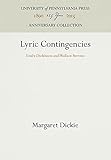Lyric Contingencies : Emily Dickinson and Wallace Stevens / Margaret Dickie.
Material type: TextPublisher: Philadelphia : University of Pennsylvania Press, [2016]Copyright date: ©1991Edition: Reprint 2016Description: 1 online resource (200 p.)Content type:
TextPublisher: Philadelphia : University of Pennsylvania Press, [2016]Copyright date: ©1991Edition: Reprint 2016Description: 1 online resource (200 p.)Content type: - 9780812230772
- 9781512801651
- 811.3 22
- PS303
- online - DeGruyter
| Item type | Current library | Call number | URL | Status | Notes | Barcode | |
|---|---|---|---|---|---|---|---|
 eBook
eBook
|
Biblioteca "Angelicum" Pont. Univ. S.Tommaso d'Aquino Nuvola online | online - DeGruyter (Browse shelf(Opens below)) | Online access | Not for loan (Accesso limitato) | Accesso per gli utenti autorizzati / Access for authorized users | (dgr)9781512801651 |
Frontmatter -- Contents -- Acknowledgments -- Abbreviations -- Chapter 1: “They shut me up in Prose”: Introduction -- Chapter 2: “The dazzled Soul / In her unfurnished Rooms”: Dickinson and the Lyric Self -- Chapter 3: “A nearness to Tremendousness”: Dickinson and Metonymy -- Chapter 4: “Who goes to dine must take his Feast”: Dickinson and Her Audience -- Interchapter -- Chapter 5: “He that of repetition is most master”: Stevens and the Lyric Self -- Chapter 6: “To picnic in the ruins that we leave”: Stevens and Metonymy -- Chapter 7: “A world impossible for poets”: Stevens and His Audience -- Chapter 8: “So summer comes in the end to these few stains”: Conclusion -- Notes -- Index of Works Cited -- General Index -- Backmatter
restricted access online access with authorization star
http://purl.org/coar/access_right/c_16ec
In Lyric Contingencies Margaret Dickie brings Wallace Stevens and Emily Dickinson together to explore the ways in which the lyric genre is eccentric to, even disruptive of, the Emersonian tradition that has shaped American literary history. Dickie contends that although Stevens and Dickinson represent different moments of cultural crises, different genders, and different and private lives, they faced similar problems of expression and similar formal and cultural restraints in their devotion to the lyric genre. Dickie considers those elements of the lyric that set it apart from both prose and narrative poetry: its speaker, its insistence on artifice, and its relation to an audience. By concentrating on these, she examines the radically experimental ways in which Dickinson and Stevens used the genre to question cultural certainties of gender, language, and the nature of the individual.
Mode of access: Internet via World Wide Web.
In English.
Description based on online resource; title from PDF title page (publisher's Web site, viewed 23. Jul 2020)


